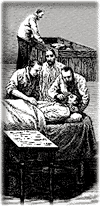
|

|

The Technology of Surgery Here is a rather dry description, from an online catalog of training videos in cardiovascular surgical techniques, of an operation that took place in 1992:
At the end of February, Dr. Ian Wilmut and his colleagues at Edinburgh's Roslin Institute introduced the world to a sheep named Dolly. Dolly is the first mammal to have been cloned from an adult animal. The world has greeted her with curiosity and excitement. But there has also been a distinct chill.
What underlies most of this anxiety is the sense that the cloning is unnatural. And that the cloning of human beings is particularly so. It is. This is unquestionable. It is also unnatural to cut into the body of a six-day-old infant, break open its chest cavity, and correct the congenital heart defect that is threatening its life. The natural thing is to let the child die. Surgery is a shocking act of violation. Literally so: prior to the development of anaesthesia in 1846, the practice was difficult to distinguish from butchery. And before Joseph Lister introduced antiseptics in 1867, the elements to which surgery exposed the patient were usually enough to prove lethal. And yet we have come to grips with it. Today operations are performed every day in every city and large town in the industrial world. Surgery is a common cultural practice. But it is hardly natural. It is as stark and direct an application of technology to the human body as you will find outside of a battlefield. Let us reacquaint ourselves with this common cultural practice. The general problem is simple. Some structure within the body is malfunctioning and must be repaired or excised. The only way to get at this structure is through the barrier that separates the outside from the inside. Anaesthesia makes it possible to approach the problem; sterile technique keeps the procedure from killing the patient. The rest is the surgeon's experience and skill. It is demanding work. Surgeons need to be able to unerringly identify the structures of the body by sight, even when viewing these structures through a small incision which is rapidly filling with blood. They need the kind of practiced dexterity that allows them to break off ribs without tearing the heart, remove diseased stretches of intestine and splice what remains together, and tie knots one-handed. The work is physically trying; surgeons often spend hours in surgery standing motionless, retractor in hand, holding open an incision while another surgeon cuts and peels. Most of the work consists of hands working on the body, neither of which have changed in the last hundred years. In many ways, a surgeon practicing at the turn of this century would not feel out of place in a modern operating room. This is not to say that surgery exists entirely outside the world of modern technology. A host of technologies mitigate the invasiveness of surgery, or prevent it altogether. However unsettling nuclear medicine might be (the thyroid cancer patient is told, upon receiving his dose of iodine 131, not to allow another person to approach within a meter for three days), it destroys tumors without opening the body. Angioplasty delays or prevents open-heart surgery, and with laporoscopy, once-traumatic operations like tubal ligation can nearly be done on an outpatient basis. Technologies have broadened the range of tools that a surgeon has available to do the work of cutting and repairing. Lasers have found a place in the operating room, particularly in optic surgery. More common, and much simpler, is the Bovie, a standard scalpel equipped with a foot switch-controlled electric cauterizer. Surgeons swear by it. The most vital area in which machines which we would recognize as high-technology come in is imaging. Medical imaging technologies, from X-rays to the MRI, let surgeons see what is going inside the body without opening it. Without imaging, surgeons have distressingly little to go on when deciding whether or not to operate: such symptoms as they can observe, and such sensations as frightened and unschooled patients can recount. Imaging reduces the mystery and helps surgeons plan their approach. And it often allows them to do what they most prefer to, which is to not perform surgery in the first place. Because as surgeons all know, surgery is dangerous. Something as risky and as manifestly unnatural as surgery is ought to horrify us. The ethical questions that surgery has brought to the fore over its brief history could (and do) fill textbooks. But they are also the stuff of television dramas. As Dostoyevsky observed, man is the animal that can get used to anything, and we have gotten used to surgery. We should ask ourselves just how that happened, so that we can see what it will be like to get used to Dolly. |
rlauriston said: I narrowly avoided a car crash once--saw a truck losing control, floored the engine, looked in the rearview, and saw the truck jack-knifed across all four lanes of Interstate 80, and cars smashed up every which way. I think maybe that was when I refused to ride in cars for a couple of years. In any case it was much more disturbing than any of the three relatively minor crashes I was actually in myself. But it didn't make me horny--maybe that's because Rosanna Arquette wasn't along for the ride. Most Active Topics: Topic 108 Sites - Feedback from visitors Topic 98 C-Topia Zeit and Nancy Swim the Channel Topic 101 C-topia Prepping for Utne | |||
| ||||
Also in Technos: The Technology of Surgery Our New Cathedral Beethoven's Fifth Symphony | ||||
|
electric minds |
virtual community center |
world wide jam |
edge tech |
tomorrow |
conversations
Any questions? We have answers.
©1996, 1997 electric minds, all rights reserved worldwide.
|

